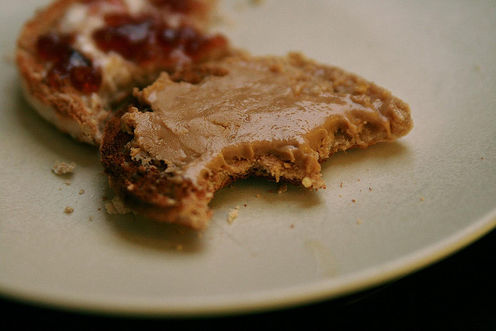
Rates of food allergies have increased over recent decades and are at an all-time high. While we don’t know the full extent of the allergy epidemic, the rate of hospitalisation for food allergies has quadrupled since the mid-90s.
Peanuts are one of the most common causes of food allergies. The HealthNuts study tested almost 3,000 Melbourne children born between 2006 and 2009 and found 3% of infants had a confirmed peanut allergy. Only one in five children had grown out of the allergy by four years of age.
Researchers have made some promising steps forward in developing a treatment for peanut allergies, but there is currently no cure. Avoiding the food is the only way to prevent allergic reactions.
What is a peanut allergy?
Peanut allergies occur when the body’s immune system develops antibodies – called immunoglobulin (Ig) E molecules – against parts of the “harmless” peanut protein. This is known as sensitisation.
Sensitisation can be easily detected by measuring peanut-specific immunoglobulin E either in the child’s blood or by means of a skin prick test.
Allergy as a disease is seen when IgE antibodies activate the immune system. This may lead to face, lip, eye swelling, welts and hives, breathing difficulties, vomiting, and even collapse of the body’s blood circulation.
The most severe form of reaction, anaphylaxis, can cause swelling of the tongue and throat. This is a potentially life-threatening condition that requires emergency treatment with adrenalin autoinjectors (also known by the brand name, EpiPen).
But not everybody who has IgE antibodies to “peanut” will experience an allergic reaction.
Sometimes peanut sensitisation is found in a child who has never been exposed to peanuts. This is more common in children with eczema or children who have other food allergies.
In other cases, the symptoms cannot be unequivocally attributed to allergy and/or exposure to peanut. In these situations, the question has to be resolved: is it “only” peanut sensitisation or is it a peanut allergy?
Causes
The causes of sensitisation are unknown but research suggests it could occur through the skin in children with eczema.
Other factors affecting this meteoric rise could be cleaner and more hygienic environments and the delayed introduction of allergenic foods.
Diagnosis
If a patient presents with symptoms of allergic reaction after eating peanuts, a positive skin prick test to peanuts or detecting the presence of specific IgE to peanuts by a blood test, will confirm the peanut allergy.
However, if the history is ambiguous or sensitisation is seen in the absence of a known exposure to peanut, the patient may need to undergo a food challenge to confirm the peanut allergy. As this could lead to an allergic reaction, food challenges need to be performed in a clinical setting, where treatment is readily available.
Our Newcastle Peanut Anaphylaxis Predictors study showed that the combination of an antibody test and a breathing test that measures a molecule called nitric oxide in exhaled air can avoid the need for a food challenge test in half of the children suspected to have peanut allergy.
Building on this approach, we have developed a blood test to predict anaphylaxis, which is currently being validated in a large population of children with suspected peanut allergy.
Treatment
Most children with peanut allergy need to carry an adrenaline autoinjector because it provides immediate relief from severe allergic reactions.
The uncertainty of when a severe reaction will occur places immense psychological and social burdens on patients and families. As a consequence, a number of children with peanut allergy suffer from anxiety-based disorders.
Encouragingly, researchers have recently made progress in optimising immunotherapy, also called peanut “desensitisation”. In this process small amounts of peanut protein is administered regularly to build up “tolerance” to the food.
British scientists Leonard Noon and John Freeman were the first to show in 1911 that desensitisation to pollen could be an effective treatment for hay fever.
A century later, a study with 28 children in Durham, North Carolina, showed that oral immunotherapy could reduce allergic reactions to peanut.
This study was subsequently confirmed by the STOP II trial in Cambridge, UK where 62% of children with peanut allergy were able to eat five to ten peanuts without allergy symptoms six months after the initiation of treatment.
Recently, Professor Mimi Tang and co-workers from the Murdoch Childrens Research Institute, Melbourne, studied an oral probiotic peanut combination immunotherapy in 62 allergic children without previous anaphylaxis. Children enrolled in this study were regularly given small amounts of a peanut and probiotic combination so as to develop tolerance to peanut.
This treatment resulted in 82% of children being “tolerant” to peanuts, meaning they were able to eat roughly 20 to 40 peanuts without allergy symptoms, two to five weeks after the treatment stopped. This suggests that there may be a treatment in the future, which has a sustained effect.
However, treatment side-effects with oral peanut (and probiotic combination) immunotherapy are very common, with 45% to 93% of children affected. That’s why oral peanut immunotherapy can only be provided within high-level specialist care and at present is advisable to do only within research settings.
In future, we hope to be able to use bio-markers to predict whether children who come into contact with peanuts will have anaphylaxis and whether they’ll respond to different treatments.
Rani Bhatia has received funding from Hunter Children’s Research Foundation. She is an inventor on a provisional patent that describes a marker for peanut allergy
Adam Collison receives funding from Hunter Children’s Research Foundation and the Thrasher Research Fund. He is an inventor on a provisional patent that describes a marker for peanut allergy.
Joerg Mattes receives/has received funding from the NHMRC, Hunter Medical Research Institute, Asthma Australia and the CRC for Asthma. He is an inventor on a provisional patent that describes a marker for peanut allergy.
